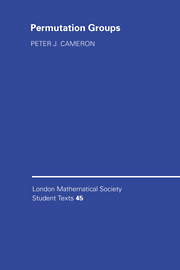4 - The O'Nan–Scott Theorem
Published online by Cambridge University Press: 06 January 2010
Summary
Introduction
We have already seen two reductions for a finite permutation group:
(a) An intransitive group is a subcartesian product of its transitive constituents.
(b) A transitive but imprimitive group is contained in the iterated wreath product of its primitive components.
These enable many questions about arbitrary groups to be reduced to the case of a primitive group and hopefully solved there. In this section, we make one further reduction, and then attempt to describe the ‘basic’ building blocks we have reached.
The socle of a finite group G is the product of the minimal normal subgroups of G. (The original meaning of the word is ‘the base on which a statue stands’.) The socle is a normal subgroup whose structure can be described: it is a direct product of finite simple groups (but, in general, not all of these simple groups are isomorphic). We will see that, for a primitive group G, either the socle is a product of isomorphic finite simple groups in a known permutation action, or G itself is almost simple. In many practical problems, we can then appeal to the Classification of Finite Simple Groups (CFSG) to reach a conclusion in the last case.
A version of this theorem (though without much of the detail) which is sufficient for some of the applications appears in Jordan's Traité des Substitutions. But since the use of the theorem depends on knowledge of the finite simple groups which was not available for 120 years after Jordan, his result was forgotten.
- Type
- Chapter
- Information
- Permutation Groups , pp. 99 - 130Publisher: Cambridge University PressPrint publication year: 1999



